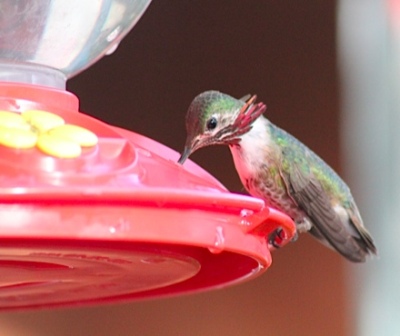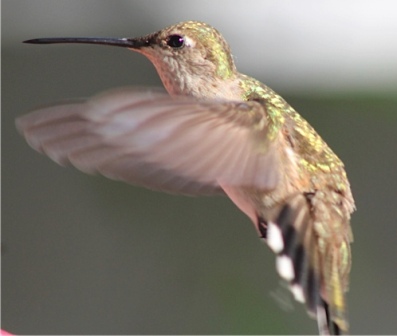A humming good time

WHEN I SEE the first hummingbirds of the season, I can’t help but crack a smile. It’s a total celebration.
Spring into summer brings them to New Mexico. First at the feeders are the Black-chinned Hummingbirds, and right alongside come the Broad-tailed. They zip and zoom around the feeders and try to set up feeding territories. Once this is established, both species focus on mating and nesting. The female is the one who builds the nest. She uses available vegetation and spider webs.
The webs make the nest strong and flexible, so it will fit her form and the two eggs that she normally lays. After the eggs hatch, the nest will continue to expand as the babies grow. In midsummer, if bugs and nectar cooperate, she will abandon her old nest, build a new one, and raise a new clutch of babies.
Hummingbirds do not live by nectar alone. They eat a crazy amount of various small bugs. What a great way to help keep down aphids, gnats, and mosquitoes!
Midsummer brings Rufous Hummingbirds from up north. They reproduce in the Yukon region, and the males migrate to the Southwest, leaving the females to raise the young. After the babies are fledged, females and their young will join the males until autumn.

When
the Rufous Hummingbirds arrive, they set up territories on feeders and
chase off the Black-chinned and Broad-tailed. It helps to have more than
one feeder in the area to cut down on this behavior. I keep several
feeders around 3 to 5 feet from each other, which keeps the Rufous from
establishing territory and greatly reduces aggression.
Midsummer also brings the Calliope Hummingbird, the smallest in North
America. Their name comes from the feather pattern on the throat, or
gorget, which look like the bright red bars or pipes of the calliope
organ.
If you want to attract this magnificent group of birds to your home,
simply set up a feeder in a shaded area of the yard or portal. Shade is
important, because hot nectar will burn them and they won’t come back.

Fill the feeders with a mixture of 1 part sugar to 4 parts water. I
find the easiest way is to pour a cup of sugar into a pitcher, add two
cups of hot water and mix quickly for 30 seconds with a wooden spoon to
dissolve. Then add two more cups of cold water. Any excess can be kept
in the refrigerator for later.
Make sure you wash your feeders each time you refill, to keep sugar
mold down. If a feeder hasn’t emptied in a few days, clean and replace
the nectar, because sugar quickly ferments and turns into alcohol.
Planting flowers is another excellent way to attract hummingbirds to
your home. Trumpet vine will attract a great number of hummingbirds and
will also provide them with shelter for nesting. Other flowers that
attract hummingbirds include Columbine, Fuchsia, Red Hot Poker,
Honeysuckle, and Salvia, just to name a few. What a great way to
brighten your home and yard! But please consider buying from a local
organic greenhouse. Pesticides can be extremely toxic to hummingbirds.
Happy birding!
Kurt
Miller manages the wild bird store at Feathered Friends of Santa Fe. An
aviculturist since age 13, he became a falconer in his early 20s and is
training as an ornithologist through Cornell University. He leads
birding tours in northern New Mexico. Reach him at
featheredfriends@cnsp.com.
